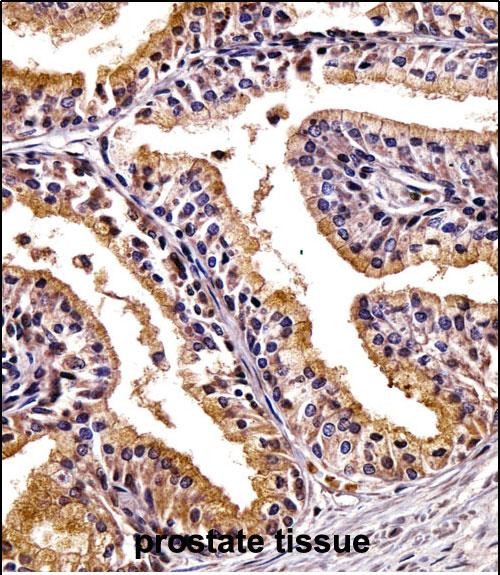PHLDA2 Antibody (C-term)
Affinity Purified Rabbit Polyclonal Antibody (Pab)
- 产品详情
- 实验流程
- 背景知识
Application
| WB, IHC-P, E |
|---|---|
| Primary Accession | Q53GA4 |
| Other Accession | NP_003302.1 |
| Reactivity | Human |
| Host | Rabbit |
| Clonality | Polyclonal |
| Isotype | Rabbit IgG |
| Calculated MW | 17092 Da |
| Antigen Region | 90-119 aa |
| Gene ID | 7262 |
|---|---|
| Other Names | Pleckstrin homology-like domain family A member 2, Beckwith-Wiedemann syndrome chromosomal region 1 candidate gene C protein, Imprinted in placenta and liver protein, Tumor-suppressing STF cDNA 3 protein, Tumor-suppressing subchromosomal transferable fragment candidate gene 3 protein, p17-Beckwith-Wiedemann region 1 C, p17-BWR1C, PHLDA2, BWR1C, HLDA2, IPL, TSSC3 |
| Target/Specificity | This PHLDA2 antibody is generated from rabbits immunized with a KLH conjugated synthetic peptide between 90-119 amino acids from the C-terminal region of human PHLDA2. |
| Dilution | WB~~1:1000 IHC-P~~1:100~500 E~~Use at an assay dependent concentration. |
| Format | Purified polyclonal antibody supplied in PBS with 0.09% (W/V) sodium azide. This antibody is purified through a protein A column, followed by peptide affinity purification. |
| Storage | Maintain refrigerated at 2-8°C for up to 2 weeks. For long term storage store at -20°C in small aliquots to prevent freeze-thaw cycles. |
| Precautions | PHLDA2 Antibody (C-term) is for research use only and not for use in diagnostic or therapeutic procedures. |
| Name | PHLDA2 |
|---|---|
| Synonyms | BWR1C, HLDA2, IPL, TSSC3 |
| Function | Plays a role in regulating placenta growth. May act via its PH domain that competes with other PH domain-containing proteins, thereby preventing their binding to membrane lipids (By similarity). |
| Cellular Location | Cytoplasm. Membrane; Peripheral membrane protein |
| Tissue Location | Expressed in placenta and adult prostate gland. In placenta, it is present in all cells of the villous cytotrophoblast The protein is absent in cells from hydatidiform moles. Hydatidiform mole is a gestation characterized by abnormal development of both fetus and trophoblast. The majority of hydatidiform moles are associated with an excess of paternal to maternal genomes and are likely to result from the abnormal expression of imprinted genes (at protein level) Expressed at low levels in adult liver and lung, and fetal liver Expressed in adult brain and neuroblastoma, medullablastoma and glioblastoma cell lines. |
For Research Use Only. Not For Use In Diagnostic Procedures.
Provided below are standard protocols that you may find useful for product applications.
BACKGROUND
This gene is located in a cluster of imprinted genes on chromosome 11p15.5, which is considered to be an important tumor suppressor gene region. Alterations in this region may be associated with the Beckwith-Wiedemann syndrome, Wilms tumor, rhabdomyosarcoma, adrenocortical carcinoma, and lung, ovarian, and breast cancer. This gene has been shown to be imprinted, with preferential expression from the maternal allele in placenta and liver.
REFERENCES
O'Seaghdha, C.M., et al. Hum. Mol. Genet. 19(21):4296-4303(2010)
Edenberg, H.J., et al. Alcohol. Clin. Exp. Res. 34(5):840-852(2010)
Sugiyama, N., et al. Mol. Cell Proteomics 6(6):1103-1109(2007)
Tang, K.F., et al. Biochim. Biophys. Acta 1770(5):820-825(2007)
Bertheau, P., et al. PLoS Med. 4 (3), E90 (2007) :
终于等到您。ABCEPTA(百远生物)抗体产品。
点击下方“我要评价 ”按钮提交您的反馈信息,您的反馈和评价是我们最宝贵的财富之一,
我们将在1-3个工作日内处理您的反馈信息。
如有疑问,联系:0512-88856768 tech-china@abcepta.com.























 癌症的基本特征包括细胞增殖、血管生成、迁移、凋亡逃避机制和细胞永生等。找到癌症发生过程中这些通路的关键标记物和对应的抗体用于检测至关重要。
癌症的基本特征包括细胞增殖、血管生成、迁移、凋亡逃避机制和细胞永生等。找到癌症发生过程中这些通路的关键标记物和对应的抗体用于检测至关重要。 为您推荐一个泛素化位点预测神器——泛素化分析工具,可以为您的蛋白的泛素化位点作出预测和评分。
为您推荐一个泛素化位点预测神器——泛素化分析工具,可以为您的蛋白的泛素化位点作出预测和评分。 细胞自噬受体图形绘图工具为你的蛋白的细胞受体结合位点作出预测和评分,识别结合到自噬通路中的蛋白是非常重要的,便于让我们理解自噬在正常生理、病理过程中的作用,如发育、细胞分化、神经退化性疾病、压力条件下、感染和癌症。
细胞自噬受体图形绘图工具为你的蛋白的细胞受体结合位点作出预测和评分,识别结合到自噬通路中的蛋白是非常重要的,便于让我们理解自噬在正常生理、病理过程中的作用,如发育、细胞分化、神经退化性疾病、压力条件下、感染和癌症。







